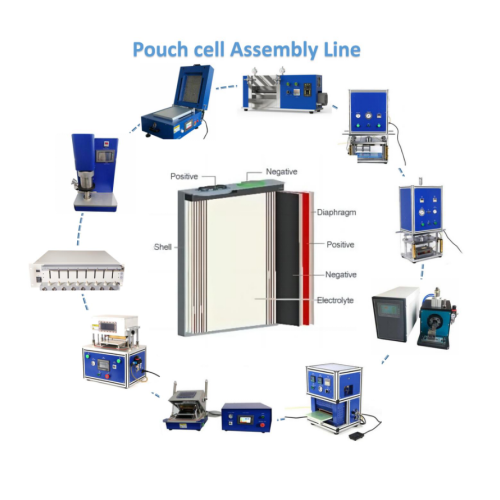A
pouch cell assembly plant is a facility specifically designed for the mass production of pouch-type lithium-ion batteries. It encompasses a range of equipment, processes, and quality control measures to efficiently assemble and manufacture pouch cells. Here's a detailed overview of a typical pouch cell assembly plant and its key components:
Some devices included:Battery Electrode Cuter ,battery stacking machine,pouch cell case forming machine,pouch cell ultrasonic welder,pouch cell hot sealing machine,pouch cell sealing machine , etc
Facility Layout and Infrastructure:
A pouch cell assembly plant requires a well-designed layout to ensure smooth workflow and efficient utilization of space. The facility generally includes areas for raw material storage, production lines, quality control, testing, packaging, and shipping. Adequate infrastructure such as power supply, ventilation systems, and safety measures are essential to support the operations.
Material Handling and Preparation:
The plant begins with the storage and handling of raw materials, including electrode materials (active materials, binders, conductive additives), current collectors (aluminum and copper foils), separator materials, electrolytes, and pouch casings. Proper inventory management and control systems are implemented to ensure an uninterrupted supply chain.
Coating and Drying:
The electrode materials undergo a coating process where they are uniformly applied onto the current collectors. Coating machines with precision control systems are utilized to achieve the desired coating thickness. Subsequently, the coated electrode sheets are dried in specialized drying ovens or tunnels to remove solvents and achieve optimal electrode quality.
Slitting and Stacking:
After drying, the coated electrode sheets are slit into appropriate widths and lengths using electrode slitting machines. The slitted electrodes are then stacked along with separator materials to form electrode stacks. Automated stacking machines ensure accurate alignment, tension control, and layering of the electrodes and separators.
Pouch Formation:
The electrode stacks are inserted into pouch casings, which are typically made of aluminum laminate or other suitable materials. Pouch forming machines heat and mold the flat pouch material into the desired shape, creating pouch cells with sealed edges.
Electrolyte Filling:
The assembled pouch cells undergo the electrolyte filling process. Electrolyte filling machines precisely inject the electrolyte into the pouch cells, ensuring uniform and accurate filling to achieve the desired electrolyte-to-active material ratio. Vacuum or pressure methods may be employed to remove air bubbles and ensure complete electrolyte penetration.
Sealing and Tab Welding:
Once the electrolyte is filled, the pouch cells are sealed to prevent leakage and maintain the integrity of the cells. Sealing machines apply heat or pressure to seal the pouch cells, and laser welding equipment is used to weld the tabs or leads to the external terminals, ensuring electrical connectivity.
Formation and Aging:
The sealed pouch cells undergo a formation and aging process to stabilize their performance and optimize their capacity, voltage, and overall characteristics. Formation equipment applies specific charging and discharging cycles to condition the cells and activate their electrochemical properties.
Quality Control and Testing:
Throughout the assembly process, stringent quality control measures are implemented to ensure the reliability and performance of the pouch cells. Testing equipment is utilized to measure cell voltage, perform capacity testing, impedance analysis, safety tests, and other quality assurance checks. Non-destructive and destructive testing methods may be employed to evaluate the cells' performance and compliance with industry standards.
Packaging and Shipping:
After passing the quality control tests, the pouch cells are packaged in suitable containers, such as trays, boxes, or pallets, for storage and transportation. Proper labeling and documentation are prepared for accurate tracking and compliance with regulatory requirements.
It's important to note that the specific equipment and processes in a pouch cell assembly plant may vary depending on factors such as production scale, automation level, and technology advancements. The plant layout and processes are designed to maximize efficiency, yield, and product quality while ensuring the safety of workers and compliance with relevant standards and regulations.




 Online service
Online service
